
In Greek mythology, Epione is the wife of Asclepius. Her name is derived from the word ηπιος. Epione was the personification of the soothing of pain and the care needed for recovery. With Asclepius, she was the mother of the five Asclepiades: Aceso, Aglaea, Hygieia, Iaso, Achelois and Panacaea, as listed in the Suda. She also had two sons, Machaon and Podalirius, who are mentioned in the Iliad of Homer as well as Telesphoros.

The red underwing is a moth of the family Erebidae. The species was first described by Carl Linnaeus in his 1767 12th edition of Systema Naturae.
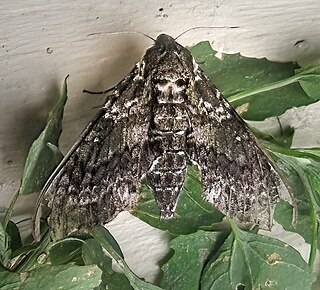
Dolba is a monotypic moth genus in the family Sphingidae erected by Francis Walker in 1856. Its only species, Dolba hyloeus, the pawpaw sphinx, was first described by Dru Drury in 1773.

Catocala is a generally Holarctic genus of moths in the family Erebidae. The genus was erected by Franz von Paula Schrank in 1802. The moths are commonly known as underwing moths or simply underwings. These terms are sometimes used for a few related moths, but usually – especially when used in plural, not as part of a species name – they are used to refer to Catocala only.
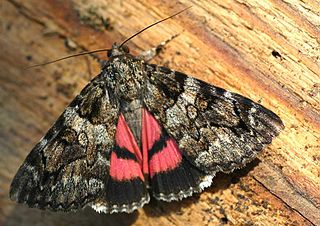
Catocala coniuncta is a circum-Mediterranean species of moth whose range extends across southern Europe, North Africa and extending to the Middle East. Its species name has for a long time been misspelled "conjuncta"; this was only corrected in 2010.

The Ourapterygini are one of the large tribes of geometer moths in the subfamily Ennominae. The tribe was described by Charles Théophile Bruand d'Uzelle in 1846. They are particularly plentiful in the Neotropics. Ourapterygini are generally held to be the youngest tribe of their subfamily, and at least seasonally have characteristic apomorphic asymmetrical processes of the anellus.

Catocala fulminea, the yellow bands underwing, is a moth of the family Erebidae. The species was first described by Giovanni Antonio Scopoli in his 1763 Entomologia Carniolica. It is found in central and southern Europe, east Asia and Siberia. The xarippe lineage has been proposed to be a distinct and valid species in its own right, instead of being only subspecifically distinct.

Catocala amestris, the three-staff underwing, is a species of Catocalini that occurs in North America. It is considered endangered and is legally protected in the state of Michigan.
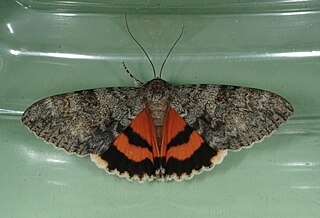
Catocala amatrix, the sweetheart underwing, is a moth of the family Erebidae. The species can be found from Nova Scotia, south through Connecticut to Florida and west through Texas and Oklahoma to Arizona and north to Montana, Minnesota, and Ontario.

Catocala retecta, the yellow-gray underwing, is a moth of the family Erebidae. The species was first described by Augustus Radcliffe Grote in 1872. It can be found in North America from southern Ontario and Quebec south through Maine and New Jersey, south through Tennessee to Georgia and west to Arkansas and Kansas and north to Wisconsin. There is one recognised subspecies, Catocala retecta luctuosa, which is sometimes treated as a valid species with the common name yellow-fringed underwing.

Catocala briseis, the Briseis underwing or ribbed underwing, is a moth of the family Erebidae. The species was first described by William Henry Edwards in 1864. It is found across the North American Boreal forest region from Newfoundland to the Pacific, south to Massachusetts and Pennsylvania.

Catocala hermia, the Hermia underwing, is a moth of the family Erebidae. The species was first described by Henry Edwards in 1880. It is found throughout the Great Plains of North America, from southern Saskatchewan and Alberta south and west to Texas, Arizona and California.

Catocala junctura, the joined underwing or Stretch's underwing, is a moth in the family Erebidae. The species was first described by Francis Walker in 1858. It is found throughout temperate North America, ranging from New York and Pennsylvania west to Montana, Colorado, Oklahoma, Arizona, and into Texas, and north to southern Illinois, extreme southern Alberta and Saskatchewan; it has also been recorded west of the Rocky Mountains from California and south-eastern British Columbia. It is typically found near water, where the food plants of its caterpillar larvae grow plentifully.
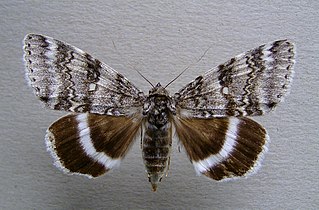
Catocala relicta, the white underwing or relict, is a moth of the family Erebidae. The species was first described by Francis Walker in 1858. It lives in southern Canada, from Newfoundland to Vancouver Island, south to Missouri, and Arizona.
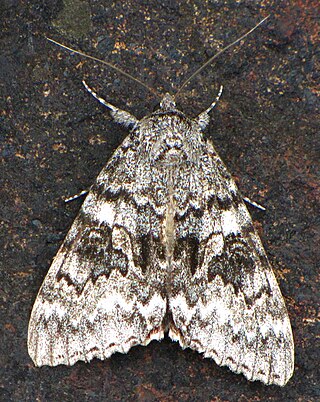
Catocala semirelicta, the semirelict underwing, is a moth of the family Erebidae. The species was first described by Augustus Radcliffe Grote in 1874. It is found in North America from Nevada, Colorado, Utah, California, and Nova Scotia south to Maine, west across Canada to British Columbia, and southward in the mountains.

Catocala ultronia, the dark red underwing or ultronia underwing, is a moth of the family Erebidae. The species was first described by Jacob Hübner in 1823. It is found in most of eastern North America, south to Florida and Texas. It ranges west across the southern parts of Canada to extreme southeast British Columbia.

Catocala conversa is a moth of the family Erebidae first described by Eugenius Johann Christoph Esper in 1787. It is found in the Mediterranean zone and parts of the sub-Mediterranean zone.

Catocala innubens, the betrothed underwing, is a moth of the family Erebidae. The species was first described by Achille Guenée in 1852. It is found in North America from southern Ontario and Quebec south through Michigan, Connecticut, Tennessee to Florida and west to Texas and Oklahoma and north to Wisconsin.

Catocala faustina is a moth of the family Erebidae. It is found from Colorado west to California and north through Washington to British Columbia. It has also been reported in Idaho, Montana, Nevada, Oregon and Utah.

Catocala pretiosa, the precious underwing, is a moth of the family Erebidae. The species was first described by Joseph Albert Lintner in 1876. It was included in Catocala crataegi by many authors, but recently it has been revalidated as a distinct species. The subspecies of pretiosa is listed as a species of special concern and believed extirpated in the US state of Connecticut.

















